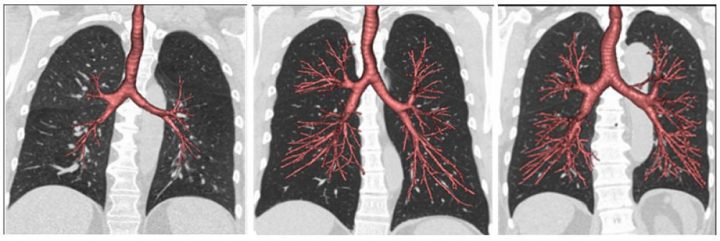According to a new study, people with small airways relative to the size of their lungs may have a lower breathing capacity and, consequently, an increased risk for COPD—even if they don’t smoke or have any other risk factors. The study, funded in part by the National Heart, Lung, and Blood Institute (NHLBI), part of the National Institutes of Health, will publish in the issue of JAMA.
Chronic obstructive pulmonary disease (COPD), a debilitating lung condition, often develops as a result of smoking, but researchers have long puzzled over why nearly a third of cases occur in people who never smoked. Now they may finally have an answer—and it may be linked to how lungs develop in certain people.

These CT scans of airways (red) and lungs (black) show the spectrum of dysanapsis, with smaller airways in proportion to lung size (left) compared with normal size airways (middle), and larger than normal airways (right). Image credit: NIH
“This work, stemming from the careful analysis of lung images of COPD patients, shows that an abnormal lung development may account for a large proportion of COPD risk among older adults,” said James Kiley, Ph.D., director of NHLBI’s Division of Lung Diseases. “More research is needed to understand what drives this occurrence and to devise possible interventions.”
COPD, the fourth leading cause of death in the United States, causes airflow blockage and breathing-related problems that can severely limit a person’s day-to-day activities. Smoking, asthma, or air pollution account for many COPD cases, but up to 30% of cases occur in people who never smoked, and only a minority of heavy smokers develop the disease, suggesting that there are other risk factors at play.
Previous research offered a clue about a possible cause, finding that about half of older adults with COPD appeared to have low lung function early in life. Benjamin Smith, M.D., a pulmonary physician in the Department of Medicine at Columbia University Irving Medical Center, New York City, who was involved in the new study, explained the phenomenon.
When people breathe, they move air through their airways, beginning with the windpipe or trachea, which branches out to smaller airways called bronchi and bronchioles. As people grow, their airways are thought to develop in proportion to their lungs, but in some people, the airways grow smaller or larger than expected—a condition called dysanapsis— for reasons that are not clear.

The illustration shows the location of the lungs. Image credit: www.medicalgraphics.de, CC BY-ND 3.0
To find out if small airways might be the culprit for COPD in people who did not smoke or have other risk factors, a team led by Smith looked at records for more than 6,500 older adults participating in three studies that included smokers and nonsmokers with and without COPD. Each study—the Multi-Ethnic Study of Atherosclerosis (MESA) Lung Study, the Subpopulations and Intermediate Outcome Measures in COPD Study (SPIROMICS), and the Canadian Cohort of Obstructive Lung Disease (CanCOLD) study—assessed dysanapsis using computed tomography (CT) scans of the lungs.
The MESA Lung study, based in six U.S. cities, included white, African American, Hispanic, and Chinese American people who were age 69 on average. The participants from the CanCOLD study were age 67 on average and came from nine Canadian cities. SPIROMICS, based at 12 U.S. medical centers, included people who were age 63 on average and reported 20 or more pack-years of smoking.
In the MESA Lung and CanCOLD studies, participants with smaller airways relative to lung size were much more likely to develop COPD compared with those with the larger airways relative to lung size. The association remained after considering standard COPD risk factors, including smoking, pollutants, and asthma.
The researchers then focused on participants from the CanCOLD study who never smoked and heavy smokers from the SPIROMICS study. Never smokers with COPD had much smaller airways relative to lung size, whereas the heavy smokers who did not have COPD had larger than normal airways.
“These results show that small airways relative to lung size are a very strong risk factor for COPD,” said Smith, the lead study author. “This helps us to understand why 30% of COPD can occur in people who never smoked.” With normal aging, lung function declines, so people who already have low lung function to begin with may develop COPD later in life, even if they don’t smoke, he explained.
Smith added that the findings may also help explain why some lifelong heavy smokers do not develop COPD. People with larger airways relative to lung size may be able to withstand lung damage from smoking and still have enough breathing reserve to prevent them from developing COPD. Still, given the multiple health problems caused by tobacco, Smith emphasized that smokers should do their best to quit.
Source: NIH
